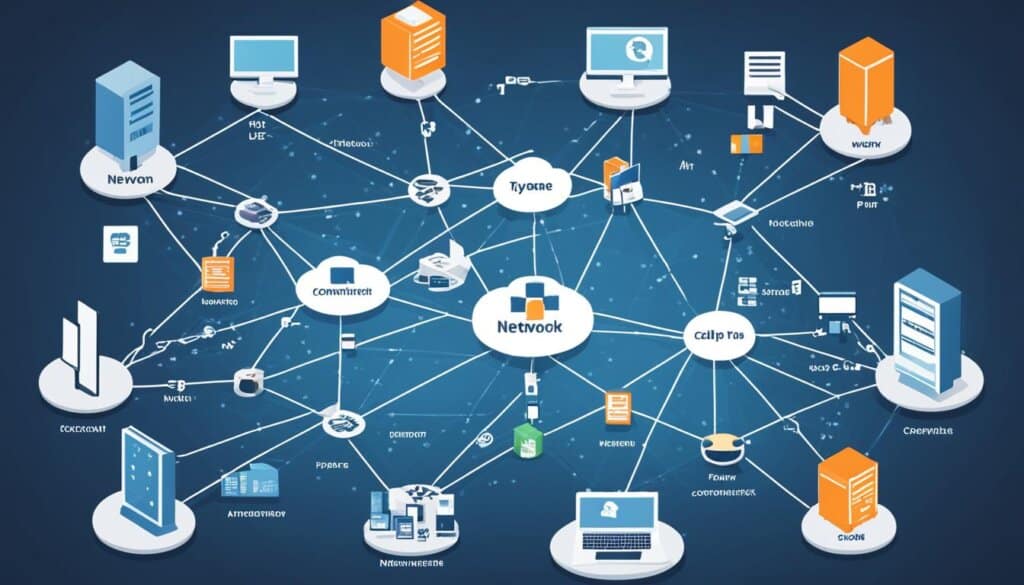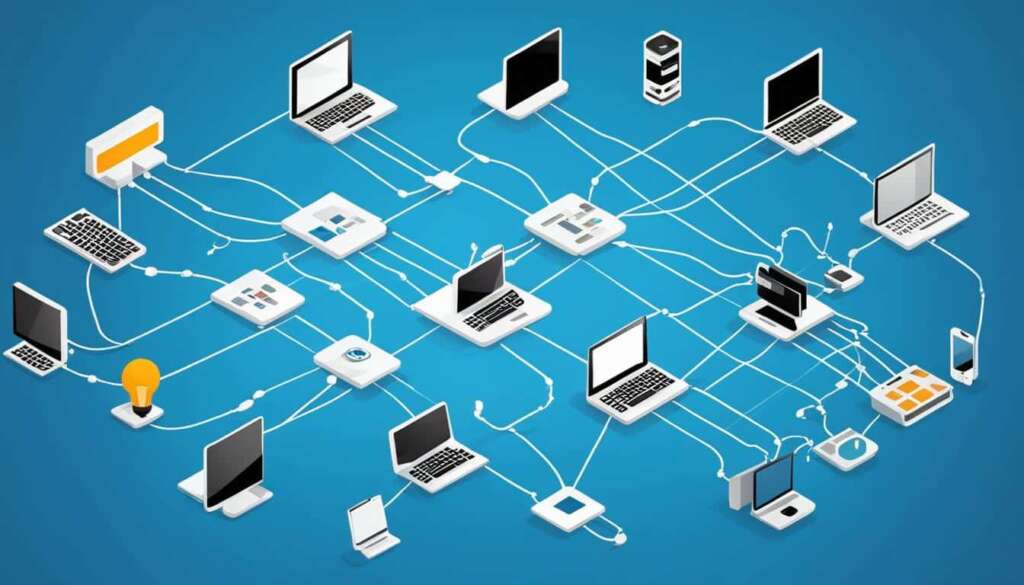Table of Contents
A network is an essential component of modern connectivity and digital communication systems. It enables the seamless exchange of information and resources between various devices, including computers, mobile phones, peripherals, and IoT devices. By connecting these devices together, a network allows for efficient data transfer and collaboration.
Networks can be wired or wireless, utilizing cables or Wi-Fi signals for communication. They facilitate connectivity not only within a single location but also across different geographical areas. Whether it’s sharing files, accessing the internet, or communicating with others, networks serve as the foundation that supports our interconnected world.
A network provides the connectivity that enables devices to interact with each other and access shared resources. It allows us to browse the web, send emails, stream videos, and engage in various online activities. Without a network, the digital landscape as we know it would not exist.
In this article, we will explore the basics of networks, how they work, the different types of computer networks, and the devices and topologies that make them function effectively. Let’s delve into the world of networks and discover the power of connectivity.
How Do Networks Work?
Networks operate on a foundation of rules and protocols that govern the transmission and reception of data. A computer network consists of interconnected devices that facilitate data exchange and enable communication between them. Each device in a network is assigned a unique identifier known as an IP address, which allows other devices to recognize and communicate with it. The physical address of a device is called the MAC address, which is associated with its network interface card (NIC).
Data exchange occurs between devices through links, which can be established through wired or wireless connections. These links enable the transfer of data packets across the network. Protocols such as TCP/IP, HTTP, and FTP define the standards and procedures for communication within a computer network. They ensure that data is transmitted accurately and efficiently while maintaining the integrity of the network.
The image below illustrates the process of data transmission and exchange in a computer network:
Understanding how networks work is essential for the efficient functioning of modern digital communication systems. With a solid grasp of network concepts and protocols, individuals and organizations can leverage computer networks to enhance connectivity and enable seamless data exchange.
Types of Computer Networks
There are several types of computer networks, each serving different purposes and covering different areas.
- Local Area Network (LAN): A LAN connects computers and devices within a small area, such as an office building or school. It provides a reliable and high-speed connection for sharing resources and data among devices in close proximity. LANs are commonly used in businesses, schools, and homes.
- Wide Area Network (WAN): A WAN covers a larger geographical area, connecting networks across regions or continents. It enables communication between geographically dispersed locations through leased lines or internet connections. WANs are essential for connecting branch offices, data centers, and remote locations.
- Wireless Local Area Network (WLAN): Similar to a LAN, a WLAN also connects devices within a small area. However, it uses wireless connections, typically over Wi-Fi, instead of physical cables. WLANs provide flexibility and convenience for mobile devices, allowing users to connect to the network without being physically connected to a wired network.
- Metropolitan Area Network (MAN): A MAN covers a larger area than a LAN but smaller than a WAN. It typically serves cities or government entities and provides high-speed connectivity within a specific geographic area. MANs are commonly used by organizations that require extensive communication within a metropolitan region.
- Personal Area Network (PAN): A PAN is a network that serves one person, connecting their personal devices. It allows for the seamless transfer of data and communication between personal devices such as smartphones, tablets, and laptops. PANs are commonly used for connecting devices using technologies like Bluetooth or USB.
Each type of network has its own characteristics and use cases, providing the foundation for seamless communication and data exchange.

Network Devices and Topology
Network devices such as routers, switches, and hubs are integral to the smooth communication and efficient data transfer within a network. Routers play a crucial role in sending information between different networks, ensuring that data packets reach their intended destinations. Whether it’s transmitting data across different offices or connecting networks across countries, routers are the backbone of effective connectivity.
Switches, on the other hand, focus on connecting devices within a single network. With their ability to intelligently direct data packets to their respective destinations, switches enable efficient communication among devices. They ensure that data is shared seamlessly between computers, printers, servers, and other networked devices within the same network.
Hubs, although less common in modern network setups, are also worth mentioning. Hubs simply act as connection points, allowing multiple devices to be linked together in a network. However, they indiscriminately broadcast data to all connected devices, which can lead to potential bottlenecks and reduced efficiency.
Network topology refers to the physical and logical arrangement of devices in a network. There are various topologies, each with its own advantages and use cases. The most common network topologies include bus, star, mesh, ring, and daisy chain configurations. Depending on factors such as scalability, fault tolerance, and cost-effectiveness, network administrators choose the most appropriate topology to meet the specific needs of their network.
FAQ
What is a network?
A network is a collection of computers, mobile phones, peripherals, and IoT devices that are connected together to enable communication and data exchange. It allows devices to share resources, such as files and data, and facilitates connectivity between devices and networks. Networks play a crucial role in enabling digital communication systems and are essential for modern connectivity.
How do networks work?
Networks work based on a set of rules or protocols that govern how data is transmitted and received. Each device connected to a network has a unique identifier, known as an IP address, which allows other devices to recognize and communicate with it. The physical address of a device is called the MAC address, which is associated with the device’s network interface card (NIC). Data is exchanged between devices through links, which can be wired or wireless connections. Protocols like TCP/IP, HTTP, and FTP define the standards for communication in a network.
What are the types of computer networks?
There are several types of computer networks, each serving different purposes and covering different areas. A Local Area Network (LAN) connects computers and devices within a small area, such as an office building or school. A Wide Area Network (WAN) covers a larger geographical area, connecting networks across regions or continents. A Wireless Local Area Network (WLAN) is similar to a LAN but uses wireless connections between devices. A Metropolitan Area Network (MAN) covers a larger area than a LAN but smaller than a WAN, typically serving cities and government entities. A Personal Area Network (PAN) is a network that serves one person, connecting their personal devices. Each type of network has its own characteristics and use cases.
What are network devices and topology?
Network devices play a crucial role in enabling communication and managing data transfer in a network. Routers are responsible for sending information between different networks, while switches connect devices within a single network and ensure data packets reach their destination. Hubs are used to connect multiple devices together. Network topology refers to the physical and logical arrangement of devices in a network, including bus, star, mesh, ring, and daisy chain configurations. The choice of network topology depends on the specific requirements and needs of the network.







